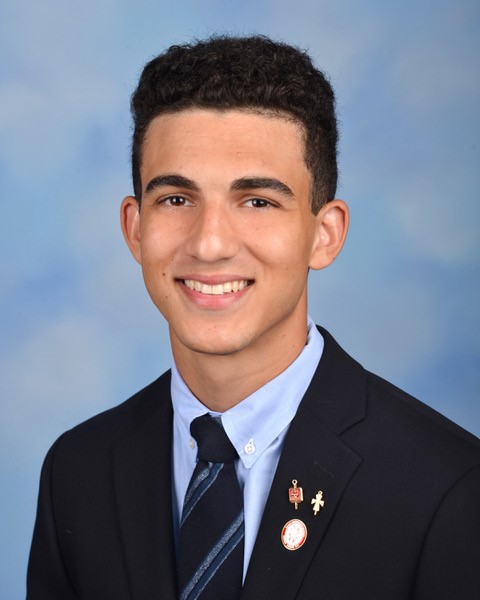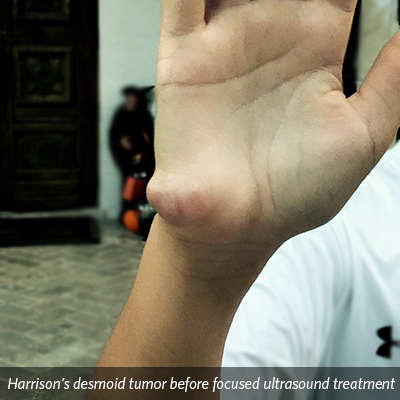By age 13, Harrison had been playing lacrosse for more than half of his life. The sport consumed the teenager’s free time, including weekends full of travel league tournaments and summers at elite sports camps. It was during a training session at camp in 2014 that Harrison noticed something was off.
 “I was doing pushups, and I felt a lump on the palm of my right hand. The trainer said it was probably a cyst and nothing to worry about.”
“I was doing pushups, and I felt a lump on the palm of my right hand. The trainer said it was probably a cyst and nothing to worry about.”
But doctors back in his hometown of Boca Raton, Florida, biopsied the mass and revealed that it was a fibromatosis tumor, or a type of desmoid tumor. Thankfully, it was a benign diagnosis, but the tumor had a good chance of spreading locally.
Within a couple of months, Harrison’s tumor had grown substantially. Doctors warned him that it could have been caused by trauma to the area, and he – with his parents’ guidance – made the difficult decision to stop playing lacrosse.
“It was terrible. I was in seventh grade, and lacrosse was my entire life. But I knew that it needed to be done for my health.”
Not long after that decision, Harrison learned the tumor was wrapping around the ulnar nerve, threatening to affect the use of his hand.
“I had a lot of tingling. The tumor was bulging out of my hand, and it was uncomfortable to write. It was also socially awkward. I would have classmates ask me what it was, and middle school is just a tough age to be different.”
Harrison and his parents traveled around the country talking to specialists in search of the right treatment option.
 “The standard treatment for this is surgery – which I wasn’t eligible for since it was too close to the nerve – and chemotherapy. Even with a low-dose chemotherapy regimen, I would have a chest port and many of the typical side effects like fatigue and nausea. It seemed drastic; there had to be something better.”
“The standard treatment for this is surgery – which I wasn’t eligible for since it was too close to the nerve – and chemotherapy. Even with a low-dose chemotherapy regimen, I would have a chest port and many of the typical side effects like fatigue and nausea. It seemed drastic; there had to be something better.”
That’s when family friend and neuroradiologist Suzanne LeBlang, MD, suggested Harrison and his family speak to Pejman Ghanouni, MD, PhD, at Stanford University.
Dr. LeBlang was using focused ultrasound therapy to treat women with uterine fibroids at her practice in Boca Raton. She knew that Dr. Ghanouni – working in collaboration with Dr. Raffi Avedian, an orthopedic oncologist, Dr. Kristen Ganjoo, a sarcoma oncologist, and Dr. Lynn Million, a radiation oncologist – was using the same treatment on patients with desmoid tumors with promising results.
“At our initial consultation, Dr. Ghanouni told me that he had treated approximately eight desmoid tumor cases to date, but this would be the first one in the hand. I knew it was experimental – and I’m sure that worried my parents immensely – but Dr. Ghanouni seemed so at ease and confident, that I wasn’t worried.”
Harrison returned to Stanford for treatment over his school’s winter break. Dr. Ghanouni used focused ultrasound therapy to noninvasively ablate – or kill – the tumor.
“He told us beforehand that he was hoping to treat 40 to 50 percent of the tumor, but in the end, he was able to treat 85 to 90 percent. It was what Dr. Ghanouni called a ‘home run.’”
Immediately after treatment, there was no visible change to Harrison’s tumor. Over time, he noticed it shrinking, and it was completely gone after about a year and a half. Now, five years later, it hasn’t returned.
“In some ways, the whole experience forced me to grow more personally than I think I would have otherwise. I started playing the tenor saxophone and was part of my school’s jazz and symphonic bands.
“Also, being in Florida, I started fishing a lot. That led me and a friend to start a charitable organization called Fillet for Friends that donates fish to homeless shelters and food banks across Florida. To date, we have donated more than 2,500 pounds of fish.”
During his senior year, Harrison made a comeback on the lacrosse field and was an Academic All-American.
Today, he is busy with his pre-med courses as a freshman at Stanford University.
“I chose to attend Stanford because of my experience being treated there – 100 percent. It changed my life completely. I truly think that Stanford is breaking the boundaries of science, and they are willing to try things that others aren’t.
“I don’t know where I would be today if Dr. Ghanouni had not had the motivation to treat patients like me. What if I had pursued other treatments and there had been complications? Or if I had undergone chemotherapy and been delayed in school? The thing that keeps me moving forward is the hope that one day I will be able to impact someone’s health and life in the way that Dr. Ghanouni did.”
